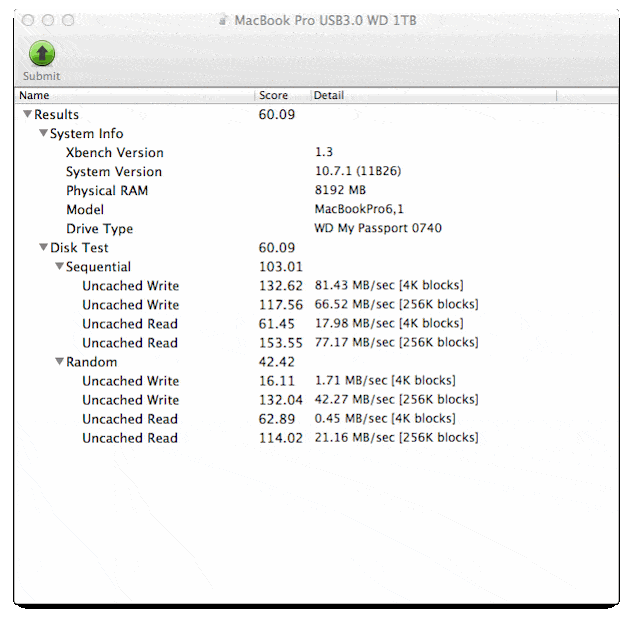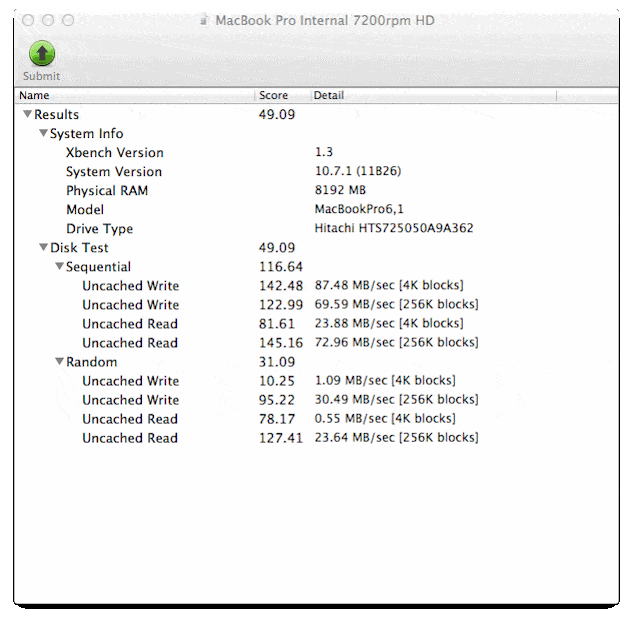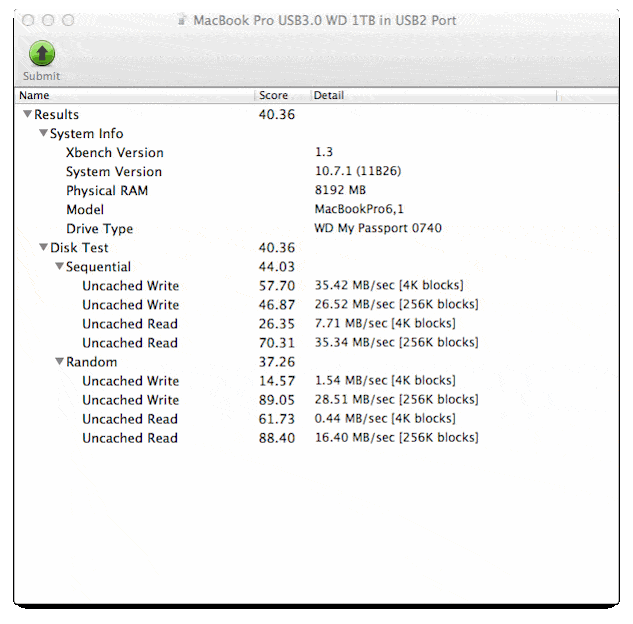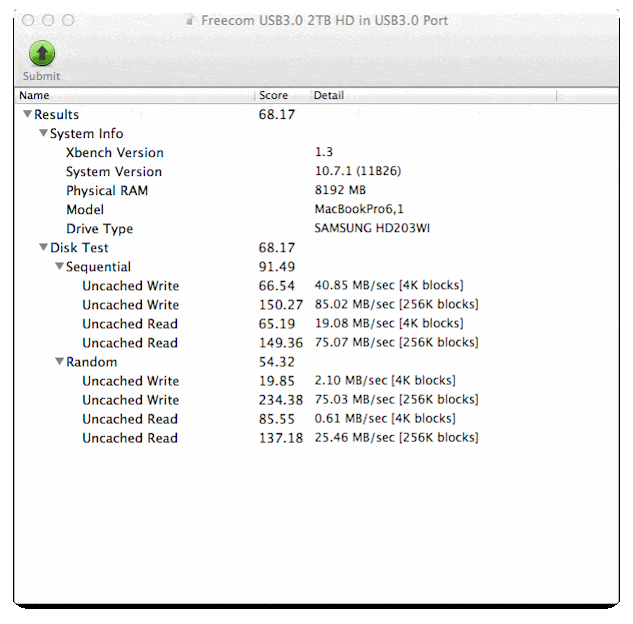Just a quick post here to share my findings having just picked up a CalDigit SuperSpeed Expresscard 34 USB3.0 adapter.
The CalDigit product line was brought to my attention recently by a friend Tim Linn. I’d been looking for a USB3.0 adapter that works with my MacBook Pro since I bought it six months ago. I’d just started using USB3.0 on Windows shortly before I jumped ship, and was disappointed that I had to take a drop in hard disk read/write speeds again. My MacBook Pro was also just before Apple introduced the Thunderbolt interface, which at 10Gbps is theoretically twice as fast as USB3.0 at 5Gbps.
Of course, the important thing to note here is that all drive and interface speeds are so very frustratingly “theoretical”. USB3.0 is purported to be 10X faster than USB2.0, which the interface may well be, on paper, but the actual speed is limited by the base drive speeds and computer power etc. To cut a long story short, I found that in practical use of a Western Digital My Passport 2.5″ USB3.0 hard disk, compared to another Western Digital My Passport 2.5″ USB2.0 hard disk, speeds varied from almost identical, to approximately 2.5X faster.
I haven’t done laboratory bench mark tests etc. but I grabbed a copy of Xbench, and did some raw tests on the drives from my 6 month old MacBook Pro laptop. Here are some screenshots of the results.
As a baseline, here are the results of running Xbench against my Internal hard drive, which is a 2.5″ drive, but I opted for the faster 7200rpm drive. It isn’t an SSD, which would have been much faster, but I figured the 7200rpm drive was a good upgrade for the money when I configured my MacBook Pro.
Next, here’s the speed of a USB2.0 hard drive. The speed drops to about 2/3 of the Internal drive.
Here’s the same USB2.0 drive plugged into the CalDigit USB3.0 Expresscard. You’ll see that this actually increases the speed of the USB2.0 hard drive.
Next up, here’s the USB3.0 hard drive, plugged into the CalDigit USB3.0 Expresscard adapter.
You can see that this is actually faster than the internal 7200rpm hard drive, which makes it a viable option for editing images in Lightroom directly from the external USB3.0 hard drive.
For comparison, I also plugged the USB3.0 drive into a USB2.0 port, and ran the Xbench drive test again.
You can see here that this is actually also 25% faster than the USB2.0 drive in the USB2.0 port.
I didn’t bother doing file transfer tests with a 3.5″ USB3.0 drive, because I will only realistically be using my 2.5″ drives when on the road. Just as a reference though, here’s the Xbench score for a Freecom 2TB USB3.0 hard drive.
You can see that this is faster than the 2.5″ 1TB Western Digital drives in the USB3.0 Expresscard adapter, so I will probably start using this drive for photo and video editing when I’m in my studio.
The above are all benchmark tests, but the score, doesn’t really give us much more than something to compare. So, I plugged 2.5″ USB3.0 drive in the CalDigit adapter, and a 2.5″ USB2.0 drive into a USB2.0 port, and copied four Lightroom library backup files, totaling 8.5GB to both drives. I didn’t do both copies at the same time. I ran one after the other.
The result is that the 8.5GB of data took 5:22 to copy to the USB2.0 drive, and 2:11 to copy to the USB3.0 drive in the USB3.0 Extpresscard adapter.
The last test I did, to get another real-world comparison, was a round trip from Lightroom to Nik Software’s Silver Efex Pro 2, creating a TIFF file on the Hard disk, opening it in Silver Efex Pro, applying a preset, then re-saving the file. There is obviously going to be a slight variance here, because I have to move my mouse around and click buttons, but basically, they both took almost exactly 1 minute until the thumbnail back in Lightroom updated to reflect the new black and white image. Oh, and I did this from the internal hard drive, and it also took just one minute, so there is really no speed gain here at all.
Conclusion
So, for now, it seems that the extra speed gain will be useful for copying files to and from the disk, especially large files like video and backup data. I’ll probably also use the USB3.0 Expresscard when editing video, as the drive is faster than my internal hard drive. But, if you buy one of these drives hoping for the promised 10X speed over USB2.0, you’ll probably be disappointed.
Product Info
Tim originally contacted me to tell me about the CalDigit VR, which is a dual 2.5″ drive RAID unit, that can be configured for speed and redundancy, and would probably scream through this Expresscard adapter. Just last week when we were communicating, I said that I probably wouldn’t get one, because it was USB2.0 not 3.0. Tim said that he was sure a USB3.0 model would be on the cards, and sure enough, when I went to check a few minutes ago, there it was, the CalDigit VR2, which looks very appealing with its USB3.0 connectivity among others.
I’m not going to run out and buy one of these just yet, as I’m good volume-wise with my current WD drives, but when I need more portable space, it will be the first place I look.
If you end up shopping for a CalDigit USB 3.0 SuperSpeed ExpressCard, this link will take you to B&H, and you’ll support this site with a small commission payment if you buy. Of course the price to you is unchanged.
You can get more product details at the CalDigit Web site here: http://www.caldigit.com/avdrive/Card_laptop.html
You can get the original CalDigit 2TB VR External Hard Drive Array with this link, and I’ll update this post with the VR2 version once it’s available on B&H.
See details of the CalDigit 2TB VR External Hard Drive Array here: http://www.caldigit.com/VR2/








Unfortunately manufacturers love putting ‘theoretical’ in their products blurbs, but suppose 10x faster sounds a lot better than 2.5x or 3.7x faster.
I haven’t tested usb 3 on macs, so found your tests useful for comparison. Thanks.
Thanks for the test. Does anyone know a test of this product using an SSD? That would really eliminate the drive as the bottleneck.
Hi Peter,
I now have a 500GB SSD in my MacBook Pro, but unfortunately, the lack of updated drivers for this card have basically rendered it useless. Every few minutes the card disconnects, and image downloads fail, so I haven’t used it for a very long time.
Cheers,
Martin.
Thanks Martin. I just ordered a CalDigit PCIe for my Mac Pro. I hope I don’t have any trouble with drivers…..
Hi Martin, do you need to plug in power adapter to the the expresscard usb 3.0 adapter when you are using it?
Hi Nimbus,
I only have to use the power cable when using power hungry hard drives. For things like card readers it’s not necessary.
I hope that helps!
Martin.
Hi Martin,
Have you had any luck with updated drivers for this card recently? I’m thinking about buying one for my 2011 macbook pro as I have a few USB 3 drives and it would be interesting to see if it effects my video editing with heavy files.
Sam.
Hi Sam,
I’ve not seen any problems with the latest drivers, but I’ve not been using the card heavily, as my main machine is now a MacBook Pro Retina USB 3.0 built in. My old MBP is still being used, with the new drivers, but I don’t use it often.
Cheers,
Martin.
Very nice review, thanks for writing it!